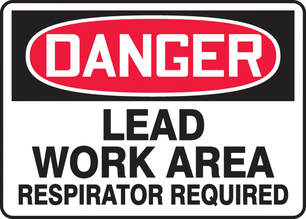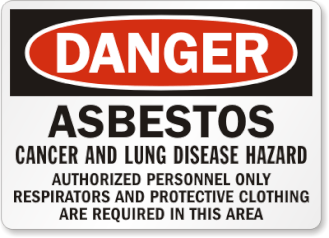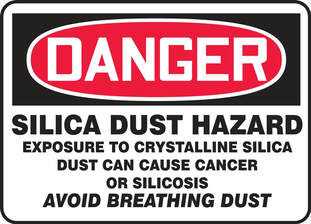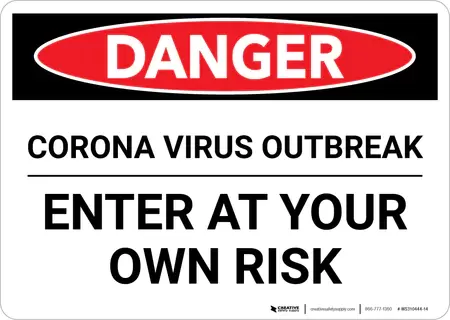|
WHAT ARE THE HAZARDS FOR WORKERS ASSOCIATED WITH LEAD, SILICA, COVID 19 AND ASBESTOS?
LEAD Lead may affect the health of workers if it is in a form that may be inhaled (i.e. airborne particles) or ingested. In order for lead to be a hazard by inhalation, lead particles that are small enough to be inhaled must get into the air. There are three types of particles: dust, fume and mist. Lead dust consists of solid particles created through processes such as blasting, sanding, grinding, and electric or pneumatic cutting. Lead fumes are produced when lead or lead-contaminated materials are heated to temperatures above 500°C, such as welding, high temperature cutting, and burning operations. The heating causes a vapor to be given off and the vapor condenses into solid fume particles. Mists are made up of liquid droplets suspended in air. The spray application of lead-based paint can generate a high concentration of lead-containing mist. SILICA Silica is one of the most common hazards on a worksite, particularly in the construction, oil and gas, manufacturing, and agriculture industries. Silica dust can cause silicosis, a serious and irreversible lung disease. It can also cause lung cancer. As workers breathe in the dust the silica settles in their lungs. ASBESTOS Asbestos fibers are easily inhaled and carried into the lower regions of the lung where they can cause fibrotic lung disease (asbestosis) and changes in the lining of the chest cavity (pleura). These diseases can lead to reduced respiratory function and death. Long-term inhalation of asbestos fibers also increases the risk of lung cancer and mesothelioma. Enlargement of the heart can also occur as an indirect effect from the increased resistance of blood flow through the lungs. COVID-19 COVID-19 is caused by infection with the severe acute respiratory syndrome coronavirus 2 (SARS-CoV-2) virus strain. Worker risk of occupational exposure to COVID 19 during the pandemic may vary from community to community, depending on local conditions or outbreaks. Exposure risk depends in part on the physical environment of the workplace, the type of work activity, the health status of the worker, the ability of workers to wear face coverings and abide by BC CDC guidelines, and the need for close contact (within 6 feet for a total of 15 minutes or more over a 24-hour period) with other people, including those known to have or suspected of having COVID 19, and those who may be infected with—and able to spread—SARS-CoV-2 without knowing it. Other factors, such as conditions in communities where employees live and work, their activities outside of work, and individual health conditions, may also affect workers’ risk of getting COVID-19 and/or developing complications from the illness. WHERE CAN YOU PURCHASE SILICA, LEAD, COVID 19 OR ASBESTOS EXPOSURE CONTROL PLAN TEMPLATES? Currently the following ECP templates are the bestselling in BC and are approved by WorkSafeBC Standards. Click on the following links to view: SILICA EXPOSURE CONTROL PLAN TEMPLATE BC LEAD EXPOSURE CONTROL PLAN TEMPLATE BC ASBESTOS EXPOSURE CONTROL PLAN TEMPLATE BC COVID 19 EXPOSURE CONTROL PLAN TEMPLATE BC WHAT ARE EMPLOYER RESPONSIBILITIES WHEN IT COMES TO EXPOSURE CONTROL PLANS? Section 6.4 of the WorkSafe BC Regulations state If a worker is or may be exposed to potentially harmful levels of asbestos, the employer must develop and implement an exposure control plan meeting the requirements of section 5.54 and to ensure adequate coordination of the overall plan, the employer must ensure that it is administered by a properly trained person. Sections 5.54 of the WorkSafeBC Regulations states: An exposure control plan must be implemented when: (a) exposure monitoring under section 5.53(3) indicates that a worker is or may be exposed to an air contaminant in excess of 50% of its exposure limit, (b) measurement is not possible at 50% of the applicable exposure limit, or (c) otherwise required by this Regulation. (2) The exposure control plan must incorporate the following elements: (a) a statement of purpose and responsibilities; (b) risk identification, assessment and control; (c) education and training; (d) written work procedures, when required; (e) hygiene facilities and decontamination procedures, when required; (f) health monitoring, when required; (g) documentation, when required. (3) The plan must be reviewed at least annually and updated as necessary by the employer, in consultation with the joint committee or the worker health and safety representative, as applicable. WHAT ARE EXPOSURE CONTROL PLANS? An Exposure Control Plan or known as ECP is a document on particular hazardous substances that provides direction and expectations to prevent exposures to workers. Depending on where you operate, your regulatory authority in BC may require you to have one or more exposure control plans. If an employer fails to develop and implement an exposure control plan, orders by WorkSafeBC can be issued to the employer to motivate action and compliance and with the potential for a stop work order. Occupational health statistics indicate that more than 50% of all fatalities in Alberta and BC are due to occupational disease. In 2015, WorkSafeBC stats indicated that there were 122 deaths due to occupational disease and 72 were due to worksite exposures. Overall, there is a trend for more claims for occupational disease/illnesses being recognized and accepted by workers compensation boards. Exposure Control Plan’s are meant to control the hazards and eliminate or mitigate the risks associated with potential exposure. Regulators want to see that prevention from occupational disease is being taken seriously and included in health and safety management systems. More than 50% of all fatalities in AB and BC are attributed to occupational disease. In 2015, out of 122 occupational disease deaths 72 were due to worksite exposures (WorkSafeBC 2015). The purpose of an Exposure Control Plan is to detail:
WHO CAN DEVELOP AN EXPOSURE CONTROL PLAN? A qualified person from the employers side may develop an ECP. Qualified means this person either has the years of experience working with the hazardous substance or has the education credentials to do so. WHAT ELSE DOES AN EMPLOYER HAVE TO DO AFTER AN ECP HAS BEEN DEVELOPED? After developing and implementing your Exposure Control Plan, employers must make sure that the controls are effective:
5 Comments
|
AuthorGreystone Safety Services BC Archives
March 2021
Categories |
-
Home
-
SAFETY MANUALS CANADA
-
Online Safety Training
- Online Joint Health and Safety Committee Training
- Online Bullying and Harassment Training
- Online Workplace Violence Training
- Online Sexual Harassment Training
- Online Traffic Control Training
- Online Fall Protection Awareness Training
- Online Confined Space Entry Awareness Training
- Online Pallet Jack Operator Training
- Online Man Lift Operator Training
- Online Scissor Lift Operator Training
- Online Forklift Operator Training
- Online Incident Investigations Training
- Online Workplace Safety Inspections Training
- Online Hazard Assessments Training
- Online Supervisor Due Diligence Training
- Online Bloodborne Pathogens Training
- Online Fire Extinguisher Training
- Online Chainsaw Safety Training
-
Safety Training
- Joint Health and Safety Committee Training BC
- Bullying & Harassment BC
- Fall Protection Training BC
- Accident Incident Investigations BC
- Lock Out Training BC
- Confined Space Entry Training BC
- Site Safety Inspections BC
- Asbestos Awareness Training BC
- Man Lift Training BC
- Lift Truck / Fork Lift Training BC
- WHMIS GHS BC 2015
- Contact
Greystone Safety Services Provides Occupational Health and Safety Consulting, OHS Safety Consultants, OHS Safety Programs & Manuals Development, Site Specific Safety Plans, OHS Safety Programs & Manuals Upgrades - Conversions, Food Safety Plans BC, Food Safety Consultants BC, OHS Safety Program Audits and Auditing, OHS Site Safety Inspections & Risk Assessments, WorkSafeBC Regulations Compliance, Safety Equipment Supplies & Products and OHS Safety Training Certification Courses across British Columbia, BC, Canada:
Vancouver, North Vancouver, West Vancouver, East Vancouver, Burnaby, New Westminster, Richmond, Surrey, Delta, Langley, Fort Langley, Maple Ridge, Coquitlam, Port Coquitlam,
Port Moody, Pitt Meadows, Mission, Abbotsford, Kelowna. Kamloops, Prince George, Victoria, Nanaimo and Westshore Langford, British Columbia, BC, Canada for over 20 years.
We can develop, audit and upgrade written occupational health and safety programs, plans and manuals for the following provinces in Canada:
VANCOUVER BRITISH COLUMBIA BC I EDMONTON ALBERTA I CALGARY ALBERTA I SASKATOON SASKATCHEWAN I WINNIPEG MANITOBA I TORONTO ONTARIO I OTTAWA ONTARIO I HALIFAX NOVA SCOTIA I SAINT JOHN MONCTON NEW BRUNSWICK I NEWFOUNDLAND LABRADOR I WORKSAFEBC I ALBERTA OHS ACT, REGULATION AND CODE I SAFEWORK MANITOBA I WORKSAFE SASKATCHEWAN I WSIB - MINISTRY OF LABOUR ONTARIO I WORKSAFE NOVA SCOTIA I WORKSAFENB I WORKPLACENL
VANCOUVER BRITISH COLUMBIA BC I EDMONTON ALBERTA I CALGARY ALBERTA I SASKATOON SASKATCHEWAN I WINNIPEG MANITOBA I TORONTO ONTARIO I OTTAWA ONTARIO I HALIFAX NOVA SCOTIA I SAINT JOHN MONCTON NEW BRUNSWICK I NEWFOUNDLAND LABRADOR I WORKSAFEBC I ALBERTA OHS ACT, REGULATION AND CODE I SAFEWORK MANITOBA I WORKSAFE SASKATCHEWAN I WSIB - MINISTRY OF LABOUR ONTARIO I WORKSAFE NOVA SCOTIA I WORKSAFENB I WORKPLACENL
© COPYRIGHT 2024 GREYSTONE SAFETY SERVICES BRITISH COLUMBIA CANADA. ALL RIGHTS RESERVED.





 RSS Feed
RSS Feed

